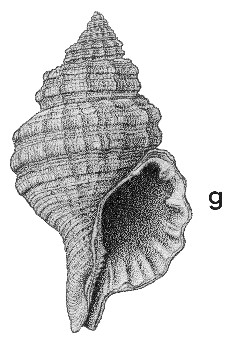
Revised descriptions of New Zealand Cenozoic Mollusca from Beu and Maxwell (1990)

 | Revised descriptions of New Zealand Cenozoic Mollusca from Beu and Maxwell (1990) | 
|
  (Pl. 48g): GS5833, Yl4/f7505, Te Piki, Cape Runaway, near East Cape, Haweran (oxygen isotope stage 7; GNS) |
Beu & Maxwell (1990): Chapter 16; p. 355; pl. 48 g.
Synonymy: Murex costatus Born 1778, p. 295 (not of Pennant, 1777); Murex parthenopeus von Salis Marschlins 1793, p. 370; Monoplex australasiae Perry 1811, pl. 3, fig. 3; Triton succinctum Lamarck 1816, "Liste des objets représentées sur les planches de cet livraison" p. 5; Triton acclivis Hutton 1873a, p. 13; see Beu (1970f, p. 229) for full list of the many synonyms; Cymatium echo Kuroda & Habe in Kira, 1961 (Japan) is now considered to be a further synonym; Cymatium (Monoplex) parthenopium parthenopium, Beu & Maxwell 1990, p. 355, pl. 48g
Type species of Monoplex Perry, 1811
Classification: Ranellidae: Cymatiinae
Description: Large for genus (80-190 mm high), ovate-fusiform, with strongly inflated whorls, moderately tall spire (equal to or slightly shorter than aperture and canal), and moderately long, straight to slightly recurved anterior canal. Whorls weakly angled (at upper third on spire whorls) by uppermost spiral cord. External sculpture dominated by very prominent, rounded, widely spaced spiral cords, 2 major ones on spire whorls and 5 (and a weak sixth) on last whorl; many weak cords on canal and sutural ramp; fine spiral threads cover much of surface, particularly in interspaces of major cords; crossing many low, widely spaced, narrow axial costae that produce weak angles in whorl coiling. Aperture large; outer lip reflected, strongly thickened to form varix, interior bearing 6 pairs of large, short ridges; inner lip coarsely ridged, with 2 ridges on parietal callus and many on columella and left edge of canal. Only a terminal varix present on most specimens, but some have 1 other on last whorl, and a few specimens have varices at each 0.67 whorl. Protoconch small, very fragile (largely horny in life), tall and narrow, of 3.5 smooth, weakly inflated whorls.
Comparison: Monoplex parthenopeus is common in sheltered rocky environments and on harbour sand flats (in the intertidal zone in early summer, laying eggs) and dredged on the shelf throughout northern and western New Zealand today. It is very widely distributed in the Mediterranean Sea, the eastern and western Atlantic, South Africa, Australia, Oman to southern Japan and Hawaii. A weakly differentiated species extends the range still more widely: M. keenae (Beu, 1970) in tropical western America and the Galapagos Islands. M. parthenopeus is easily distinguished from other Monoplex species by its small, narrow protoconch, its large size, its strongly inflated whorls, its few prominent, widely spaced spiral cords, its heavily armed aperture, and by most specimens having only a terminal varix. In life, the shell is coated with a very prominent, dark brown periostracum bearing many long bristles arranged on axial blades fringing the axial ribs of the shell. Beu (in press) adopted the former subgenera of Cymatium as full genera, in keeping with the rank of genera now used in such families as Muricidae.
Distribution: Castlecliffian-Recent (New Zealand), Early Miocene to Recent (Northern Hemisphere); several scores of synonyms have been proposed for variants of this almost cosmopolitan species in the Recent fauna, only a few of which are listed here (Mediterranean, types of Murex costatus and M. parthenopeus; Australia, type of Triton succinctum ; New Zealand, type of Triton acclivis). One fossil specimen from Wellington west coast beaches (GNS) is assumed to be Castlecliffian, but there are no other Castlecliffian records; fairly common in the Te Piki member near East Cape (Haweran, oxygen isotope stage 7, 220 000 years B.P.).
Cite this publication as: "A.G. Beu and J.I. Raine (2009). Revised
descriptions of New Zealand Cenozoic Mollusca from Beu and Maxwell (1990). GNS
Science miscellaneous series no. 27."
© GNS Science, 2009
ISBN
978-0-478-19705-1
ISSN 1177-2441
(Included with a PDF facsimile file
copy of New Zealand Geological Survey Paleontological Bulletin 58 in CD version
from: Publications Officer, GNS Science, P.O. Box 30368 Lower Hutt, New
Zealand)